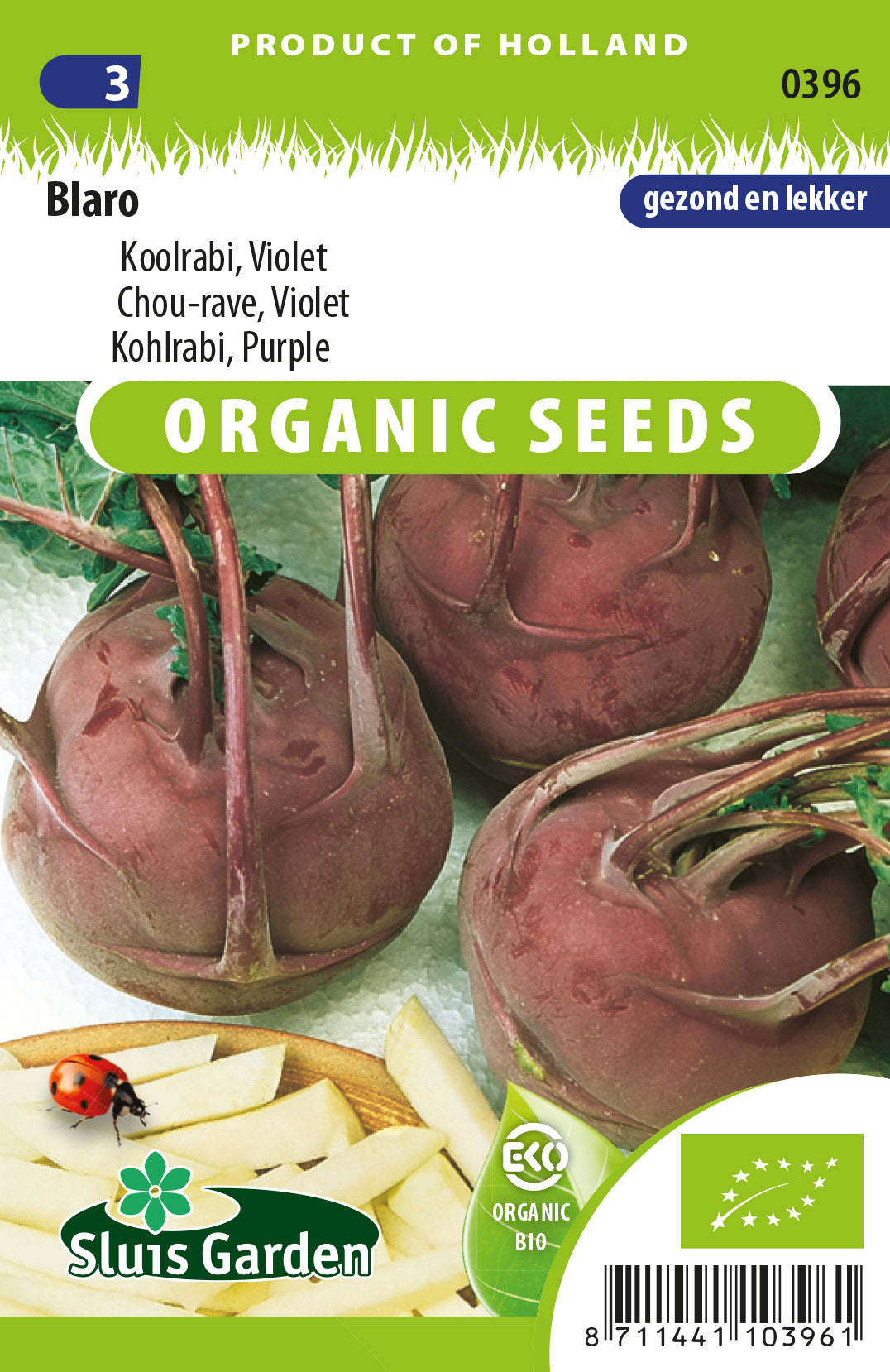1
/
of
1
Kohlrabi Blaro purple BIO
Kohlrabi Blaro purple BIO
Regular price
1.350 KWD
Regular price
Sale price
1.350 KWD
Unit price
/
per
Shipping calculated at checkout.
Couldn't load pickup availability
Growing Kohlrabi "Blaro Purple" organically involves following natural and sustainable practices without the use of synthetic chemicals. Here's a step-by-step guide to help you grow organic Kohlrabi:
**1. Soil Preparation:**
- Choose well-draining soil with a pH between 6.0 and 7.5. Add organic matter, such as compost or well-rotted manure, to improve soil fertility and structure.
**2. Planting:**
- **Timing:** Kohlrabi is a cool-season crop. Start seeds indoors 4-6 weeks before the last expected frost or directly sow seeds outdoors in early spring or late summer/early fall.
- **Spacing:** Plant Kohlrabi seeds about 1/2 inch deep and 4-6 inches apart in rows spaced 12-18 inches apart. Once seedlings emerge, thin them to stand about 8-12 inches apart.
**3. Watering:**
- Keep the soil consistently moist. Kohlrabi prefers even moisture and can become woody or tough if the soil dries out. Water deeply when needed, especially during dry periods.
**4. Mulching:**
- Apply organic mulch, such as straw or shredded leaves, around the plants to conserve soil moisture, suppress weeds, and regulate soil temperature.
**5. Fertilization:**
- Use organic fertilizers, such as compost or well-rotted manure, to provide nutrients to the soil.
- Side-dress with compost or a balanced organic fertilizer during the growing season to supply additional nutrients.
**6. Companion Planting:**
- Kohlrabi can benefit from companion plants like onions, beets, and aromatic herbs. Avoid planting it near other members of the cabbage family.
**7. Pest Control:**
- Monitor for pests like cabbage worms, aphids, and flea beetles. Handpick pests when possible, or use natural predators like ladybugs.
- Neem oil or insecticidal soap can be used as organic alternatives for pest control.
**8. Disease Prevention:**
- Practice good crop rotation to prevent soil-borne diseases.
- Proper spacing and good air circulation help reduce the risk of fungal diseases.
**9. Harvesting:**
- Harvest Kohlrabi when the bulbs are about 2-3 inches in diameter. Use a knife to cut the swollen stem just above the ground.
- Younger kohlrabi tends to be more tender and flavorful.
**10. Successive Planting:**
- For a continuous harvest, consider successive plantings every few weeks.
**11. Saving Seeds:**
- Kohlrabi is typically grown as an annual, and it is not commonly grown for seed saving. If you are interested in saving seeds, allow some plants to bolt (produce flowers and seeds) at the end of the season.
**12. Organic Certification:**
- If you wish to officially label your kohlrabi as organic, follow the guidelines and requirements set by your local organic certification body.
Growing organic Kohlrabi "Blaro Purple" involves creating a healthy and sustainable environment for your plants, promoting biodiversity, and minimizing the use of synthetic inputs. Following these practices will contribute to the overall well-being of your garden and the quality of your kohlrabi harvest.
**1. Soil Preparation:**
- Choose well-draining soil with a pH between 6.0 and 7.5. Add organic matter, such as compost or well-rotted manure, to improve soil fertility and structure.
**2. Planting:**
- **Timing:** Kohlrabi is a cool-season crop. Start seeds indoors 4-6 weeks before the last expected frost or directly sow seeds outdoors in early spring or late summer/early fall.
- **Spacing:** Plant Kohlrabi seeds about 1/2 inch deep and 4-6 inches apart in rows spaced 12-18 inches apart. Once seedlings emerge, thin them to stand about 8-12 inches apart.
**3. Watering:**
- Keep the soil consistently moist. Kohlrabi prefers even moisture and can become woody or tough if the soil dries out. Water deeply when needed, especially during dry periods.
**4. Mulching:**
- Apply organic mulch, such as straw or shredded leaves, around the plants to conserve soil moisture, suppress weeds, and regulate soil temperature.
**5. Fertilization:**
- Use organic fertilizers, such as compost or well-rotted manure, to provide nutrients to the soil.
- Side-dress with compost or a balanced organic fertilizer during the growing season to supply additional nutrients.
**6. Companion Planting:**
- Kohlrabi can benefit from companion plants like onions, beets, and aromatic herbs. Avoid planting it near other members of the cabbage family.
**7. Pest Control:**
- Monitor for pests like cabbage worms, aphids, and flea beetles. Handpick pests when possible, or use natural predators like ladybugs.
- Neem oil or insecticidal soap can be used as organic alternatives for pest control.
**8. Disease Prevention:**
- Practice good crop rotation to prevent soil-borne diseases.
- Proper spacing and good air circulation help reduce the risk of fungal diseases.
**9. Harvesting:**
- Harvest Kohlrabi when the bulbs are about 2-3 inches in diameter. Use a knife to cut the swollen stem just above the ground.
- Younger kohlrabi tends to be more tender and flavorful.
**10. Successive Planting:**
- For a continuous harvest, consider successive plantings every few weeks.
**11. Saving Seeds:**
- Kohlrabi is typically grown as an annual, and it is not commonly grown for seed saving. If you are interested in saving seeds, allow some plants to bolt (produce flowers and seeds) at the end of the season.
**12. Organic Certification:**
- If you wish to officially label your kohlrabi as organic, follow the guidelines and requirements set by your local organic certification body.
Growing organic Kohlrabi "Blaro Purple" involves creating a healthy and sustainable environment for your plants, promoting biodiversity, and minimizing the use of synthetic inputs. Following these practices will contribute to the overall well-being of your garden and the quality of your kohlrabi harvest.
Share

